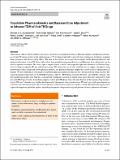Population pharmacokinetics and Bayesian dose adjustment to advance TDM of anti-TB drugs
Abstract
Tuberculosis (TB) is still the number one cause of death due to an infectious disease. Pharmacokinetics and pharmacodynamics of anti-TB drugs are key in the optimization of TB treatment and help to prevent slow response to treatment, acquired drug resistance, and adverse drug effects. The aim of this review was to provide an update on the pharmacokinetics and pharmacodynamics of anti-TB drugs and to show how population pharmacokinetics and Bayesian dose adjustment can be used to optimize treatment. We cover aspects on preclinical, clinical, and population pharmacokinetics of different drugs used for drug-susceptible TB and multidrug-resistant TB. Moreover, we include available data to support therapeutic drug monitoring of these drugs and known pharmacokinetic and pharmacodynamic targets that can be used for optimization of therapy. We have identified a wide range of population pharmacokinetic models for first- and second-line drugs used for TB, which included models built on NONMEM, Pmetrics, ADAPT, MWPharm, Monolix, Phoenix, and NPEM2 software. The first population models were built for isoniazid and rifampicin; however, in recent years, more data have emerged for both new anti-TB drugs, but also for defining targets of older anti-TB drugs. Since the introduction of therapeutic drug monitoring for TB over 3 decades ago, further development of therapeutic drug monitoring in TB next steps will again depend on academic and clinical initiatives. We recommend close collaboration between researchers and the World Health Organization to provide important guideline updates regarding therapeutic drug monitoring and pharmacokinetics/pharmacodynamics.
Citation
Sturkenboom , M G G , Märtson , A-G , Svensson , E M , Sloan , D J , Dooley , K E , van den Elsen , S H J , Denti , P , Peloquin , C A , Aarnoutse , R E & Alffenaar , J-W C 2021 , ' Population pharmacokinetics and Bayesian dose adjustment to advance TDM of anti-TB drugs ' , Clinical Pharmacokinetics . https://doi.org/10.1007/s40262-021-00997-0
Publication
Clinical Pharmacokinetics
Status
Peer reviewed
ISSN
1179-1926Type
Journal item
Description
Funding: Anne-Grete Märtson was funded by Marie Skłodowska-Curie Actions [Grant agreement no. 713660—PRONKJEWAIL—H2020-MSCA-COFUND-2015].Collections
Items in the St Andrews Research Repository are protected by copyright, with all rights reserved, unless otherwise indicated.

